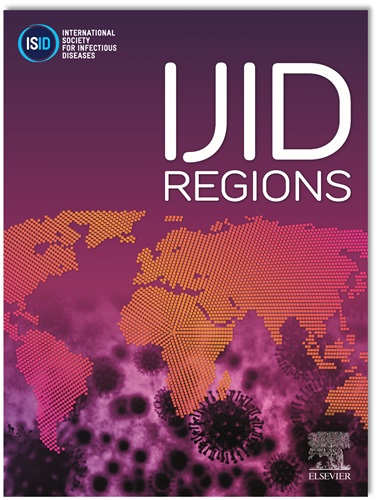在SARS-CoV-2前三角洲、三角洲和欧米克隆波中,非洲因COVID-19住院的儿童和成人的住院死亡率
IF 4.8
2区 医学
Q1 INFECTIOUS DISEASES
引用次数: 0
摘要
背景:本研究调查了非洲地区三角洲前波、三角洲波和欧米克隆波中因COVID-19住院的儿童和成人的住院死亡率。方法:我们使用来自13个非洲国家的520,810名住院儿童和成人的个人数据进行了回顾性队列研究。采用Cox比例风险回归模型评估SARS-CoV-2变异对住院死亡率的影响。结果:在儿童中,Delta波前和Delta波之间的住院死亡率风险具有可比性(aHR 1.02, 95% CI 0.77-1.35)。在成人中,δ波期间的死亡率比δ波前增加了6% (aHR 1.06, 95% CI 1.04-1.09)。与δ波相比,在欧米克隆波期间,儿童的死亡风险显著降低42% (aHR 0.58, 95% CI 0.43-0.80),成人的死亡风险显著降低59% (aHR 0.41, 95% CI 0.40-0.43)。值得注意的是,在欧米克隆波期间,患有严重或危重COVID-19的儿童、合并感染艾滋病毒的儿童以及同时感染艾滋病毒和结核病的成年人的死亡风险降低幅度不太明显。结论:尽管Omicron波期间的死亡风险普遍降低,但特定高危人群的持续高死亡率强调了按照世卫组织建议优先接种加强疫苗和加强对弱势群体治疗的重要性。本文章由计算机程序翻译,如有差异,请以英文原文为准。
In-hospital mortality among children and adults hospitalized with COVID-19 in Africa across pre-delta, delta, and omicron SARS-CoV-2 waves
Background
This study examines in-hospital mortality among children and adults hospitalized with COVID-19 across the pre-Delta, Delta, and Omicron waves in the African region.
Method
We conducted a retrospective cohort study using individual-level data from 520,810 hospitalized children and adults in 13 African countries. Cox proportional hazards regression models were used to assess the impact of SARS-CoV-2 variants on in-hospital mortality.
Findings
Among children, the risk of in-hospital mortality was comparable between pre-Delta and Delta waves (aHR 1.02, 95% CI 0.77-1.35). In adults, mortality increased by 6% during Delta wave compared with pre-Delta wave (aHR 1.06, 95% CI 1.04-1.09). During Omicron wave, mortality risk decreased significantly by 42% in children (aHR 0.58, 95% CI 0.43-0.80) and 59% in adults (aHR 0.41, 95% CI 0.40-0.43) compared to the Delta wave. Notably, the reduction in mortality risk during the Omicron wave was less pronounced for children with severe or critical COVID-19, those co-infected with HIV, and adults co-infected with either HIV or tuberculosis.
Conclusion
Despite a general reduction in mortality risk during Omicron wave, persistently high mortality in specific high-risk groups underscores the importance of prioritizing booster vaccinations and intensified treatment for vulnerable populations as per WHO recommendations.
求助全文
通过发布文献求助,成功后即可免费获取论文全文。
去求助
来源期刊
CiteScore
18.90
自引率
2.40%
发文量
1020
审稿时长
30 days
期刊介绍:
International Journal of Infectious Diseases (IJID)
Publisher: International Society for Infectious Diseases
Publication Frequency: Monthly
Type: Peer-reviewed, Open Access
Scope:
Publishes original clinical and laboratory-based research.
Reports clinical trials, reviews, and some case reports.
Focuses on epidemiology, clinical diagnosis, treatment, and control of infectious diseases.
Emphasizes diseases common in under-resourced countries.

 求助内容:
求助内容: 应助结果提醒方式:
应助结果提醒方式:


